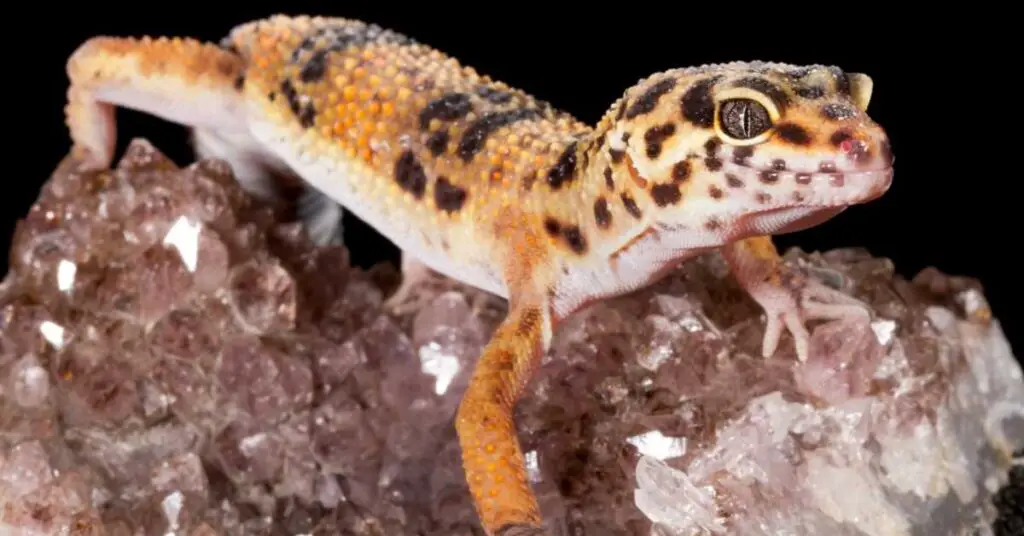Have you ever wondered if leopard geckos are truly nocturnal?
Picture this: you’re sitting in your living room late at night, observing your leopard gecko’s activities. As you watch, you can’t help but wonder if they are naturally active during the night or if they simply adjust their behavior to match their owners’ schedules.
Well, the answer might surprise you. In this discussion, we will explore the fascinating world of leopard geckos and their nocturnal nature, uncovering the factors that influence their behavior and shedding light on their sleep patterns.
Get ready to uncover the secrets of these captivating creatures and discover how you can encourage their natural behavior in your care.
Key Takeaways
- Leopard geckos are primarily nocturnal creatures, being most active during the night.
- Their feeding habits and hunting behaviors are best suited for the night when their prey is most active.
- Environmental factors such as temperature, humidity, and lighting play a significant role in shaping their behavior.
- Leopard geckos exhibit a unique sleep cycle characterized by periods of deep sleep and intermittent wakefulness, which can be influenced by temperature and lighting.
Activity Patterns of Leopard Geckos
Leopard geckos exhibit distinct activity patterns that are primarily nocturnal in nature. This means that they’re most active during the night and tend to rest during the day. Understanding their activity patterns is crucial for providing appropriate care and ensuring their well-being.
In their natural habitats, leopard geckos are found in arid and rocky regions of Iran, Afghanistan, and Pakistan. These areas are characterized by extreme temperature fluctuations, with scorching hot days and cold nights. As a result, leopard geckos have adapted to become primarily nocturnal creatures, utilizing the cover of darkness to avoid harsh daytime conditions.
During the night, leopard geckos engage in various activities such as foraging for food, hunting insects, and exploring their surroundings. Their diet mainly consists of small invertebrates like crickets, mealworms, and waxworms. These prey items provide the necessary nutrients, vitamins, and minerals for their survival and overall health.
Leopard geckos have specialized sensory organs, called Jacobson’s organs, located in their mouths. These organs allow them to detect scent particles in the environment, aiding in the detection of prey and potential predators. Their keen sense of smell and exceptional hunting abilities make them successful nocturnal predators in their natural habitats.
Understanding the nocturnal activity patterns of leopard geckos is essential for recreating suitable captive environments. By providing appropriate leopard gecko habitats that mimic their natural conditions, along with a well-balanced leopard gecko diet, we can ensure their comfort and promote their overall well-being.

Factors Influencing Leopard Gecko Behavior
Factors that influence the behavior of leopard geckos include environmental conditions, social interactions, and their physiological needs. Understanding these factors is crucial for providing appropriate care and ensuring the well-being of these fascinating creatures.
Environmental conditions play a significant role in shaping leopard gecko behavior. Temperature, humidity, and lighting are key factors that affect their activity levels, feeding patterns, and reproductive behavior. Leopard geckos are ectothermic, meaning they rely on external sources to regulate their body temperature. They prefer temperatures between 88°F to 92°F (31°C to 33°C) during the day and slightly cooler temperatures at night. Inadequate temperature gradients can lead to stress, decreased appetite, and even illness.
In addition to environmental conditions, social interactions also influence leopard gecko behavior. While they’re generally solitary animals, they may exhibit territorial behavior, especially during breeding season. Males may become aggressive towards each other, and females may display aggression when protecting their eggs. Providing adequate space and hiding spots can help reduce stress and prevent aggression among leopard geckos.
Leopard geckos also have specific physiological needs that affect their behavior. They require a varied diet consisting of live insects to meet their nutritional requirements. Insufficient nutrition can lead to health problems and abnormal behavior. Additionally, proper hydration is essential, as dehydration can negatively impact their behavior and overall health.
Understanding these factors, such as environmental conditions, social interactions, and physiological needs, is crucial in creating a suitable habitat for leopard geckos. By providing appropriate care, you can ensure your leopard gecko’s well-being and promote natural and healthy behaviors.
The Nocturnal Nature of Leopard Geckos
Understanding the factors that shape leopard gecko behavior, including environmental conditions, social interactions, and physiological needs, leads us to explore their nocturnal nature. Leopard geckos are primarily active at night, making them nocturnal creatures. This behavior is a result of their evolutionary adaptation to their natural habitat and feeding habits.
To better understand the nocturnal nature of leopard geckos, let’s consider the following:
- Leopard gecko feeding habits:
- Leopard geckos are insectivores, primarily feeding on live insects such as crickets, mealworms, and waxworms.
- Their nocturnal behavior allows them to hunt and feed during the night when their prey is most active.
- Leopard gecko habitat requirements:
- Leopard geckos are native to arid regions, such as the deserts of Afghanistan, Pakistan, and India.
- Their natural habitat consists of rocky areas with crevices and burrows, providing them with shelter and protection during the day.
- The nocturnal nature of leopard geckos allows them to avoid the extreme heat of the day and seek refuge in cooler areas.
Understanding Leopard Geckos’ Sleep Patterns
The sleep patterns of leopard geckos have been extensively studied and provide valuable insights into their nocturnal behavior. Leopard geckos exhibit a unique sleep cycle characterized by periods of deep sleep and intermittent wakefulness. During deep sleep, they appear motionless, with their eyes closed and their body relaxed. This is the time when they’re most vulnerable to predation, so they seek out safe hiding spots to ensure their protection.
Environmental influences play a crucial role in leopard geckos’ sleep patterns. The temperature and lighting conditions in their habitat greatly affect their sleep-wake cycle. Leopard geckos are ectothermic, meaning their body temperature is regulated by the external environment. As such, they rely on temperature fluctuations to regulate their sleep patterns. Cooler temperatures encourage sleep, while warmer temperatures promote wakefulness. Additionally, the presence of light also influences their sleep cycle. Leopard geckos are most active during the night, when darkness prevails. Exposure to bright lights can disrupt their sleep and lead to stress.
Understanding leopard geckos’ sleep patterns is essential for providing them with proper care and creating a suitable environment. By replicating their natural sleep conditions, such as providing hiding spots and maintaining appropriate temperature and lighting levels, you can help ensure that your leopard gecko thrives and maintains its nocturnal behavior.
Tips for Encouraging Natural Behavior in Leopard Geckos
To ensure your leopard gecko displays natural behavior, follow these tips for creating an environment that supports their instinctual needs:
Enrichment Activities:
- Provide hiding spots: Leopard geckos are nocturnal and naturally seek shelter during the day. Create hiding spots using caves, logs, or artificial plants to mimic their natural habitat.
- Offer climbing opportunities: Leopard geckos enjoy climbing and exploring their surroundings. Place branches or platforms in their enclosure to encourage this behavior. Ensure the branches are secure and won’t harm your gecko.
Creating a Natural Habitat:
- Temperature and lighting: Maintain a temperature gradient in the enclosure, with a warm side (around 88°F) and a cool side (around 75°F). Use a heat mat or ceramic emitter to provide a heat source. Additionally, provide a UVB light for 10-12 hours a day to simulate natural sunlight.
- Substrate choice: Choose a substrate that mimics their natural environment, such as reptile carpet, paper towels, or slate tiles. Avoid loose substrates like sand or wood chips, as they can cause impaction if ingested.
Frequently Asked Questions
What Are the Different Types of Activity Patterns Exhibited by Leopard Geckos?
Leopard geckos exhibit various activity patterns, including nocturnal behavior, which is their primary mode. They are most active during the night, hunting for food and engaging in social interactions. These behavioral adaptations help them survive in their natural habitat.
How Does Temperature Affect the Behavior of Leopard Geckos?
Temperature plays a crucial role in the behavior of leopard geckos. They use temperature regulation to maintain their preferred thermal preferences, which can affect their activity levels and overall behavior.
Can Leopard Geckos See in the Dark?
Leopard geckos possess excellent night vision capabilities, allowing them to navigate and hunt in low light conditions. Light plays a crucial role in regulating their behavior, as it influences their activity levels and reproductive cycles.
What Are Some Common Sleep Patterns Observed in Leopard Geckos?
Leopard geckos exhibit different stages of sleep and can be observed in various sleeping positions. Their sleep patterns are influenced by their natural nocturnal behavior, allowing them to rest during the day and be active at night.
How Can I Create a Natural Environment for My Leopard Gecko to Encourage Its Natural Behavior?
To create a stimulating habitat for your leopard gecko and encourage its natural behavior, provide a variety of hiding spots, temperature gradients, and substrates. Incorporate features like rocks, logs, and live plants to mimic their natural environment.
Conclusion
In conclusion, leopard geckos are indeed nocturnal animals. They exhibit activity patterns mainly during the night, which is influenced by their natural habitat and behavior.
Understanding their sleep patterns is essential for providing a suitable environment and promoting their overall well-being. By creating an environment that mimics their natural habitat and providing appropriate lighting and temperature conditions, leopard gecko owners can encourage their natural behaviors and ensure their optimal health.


